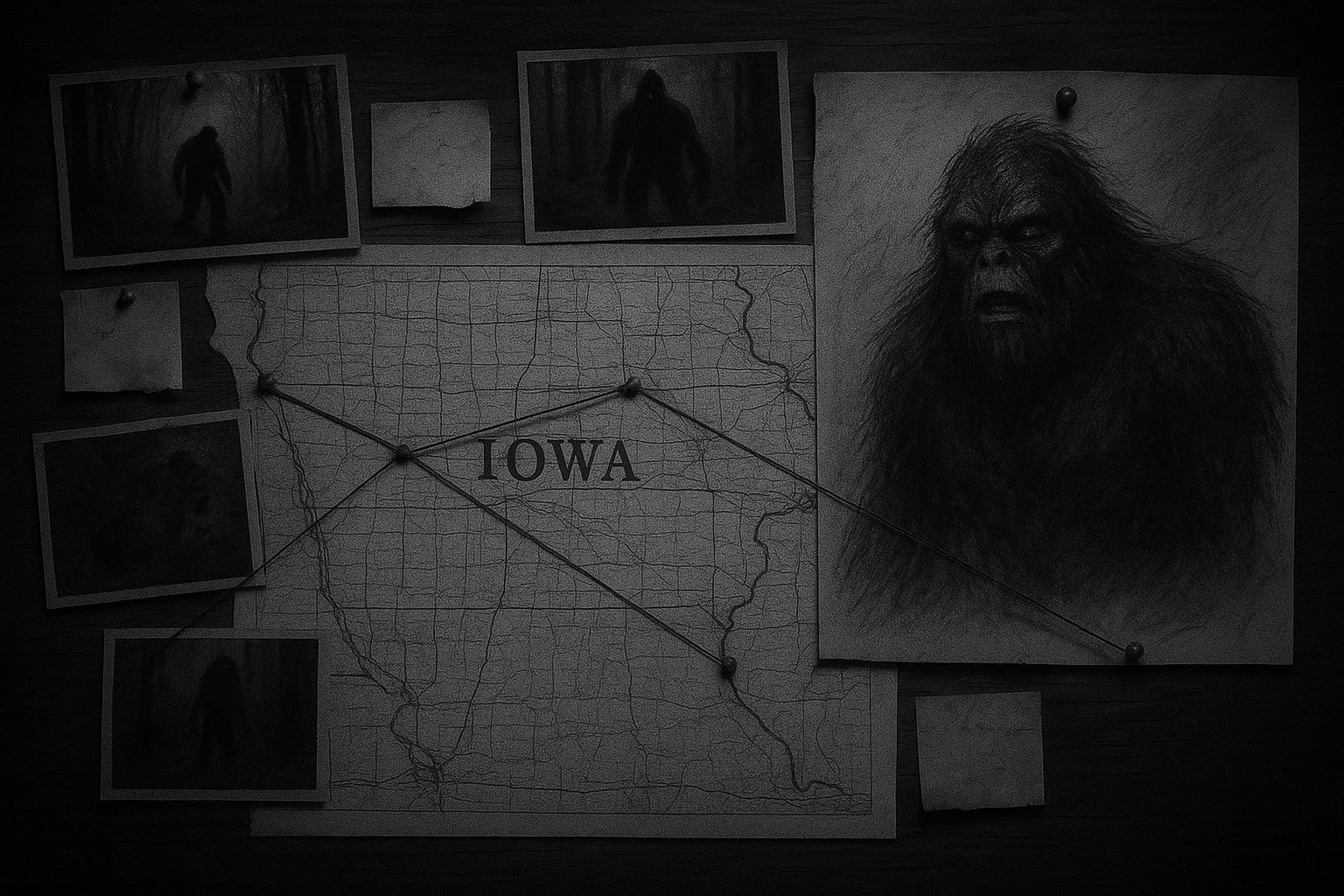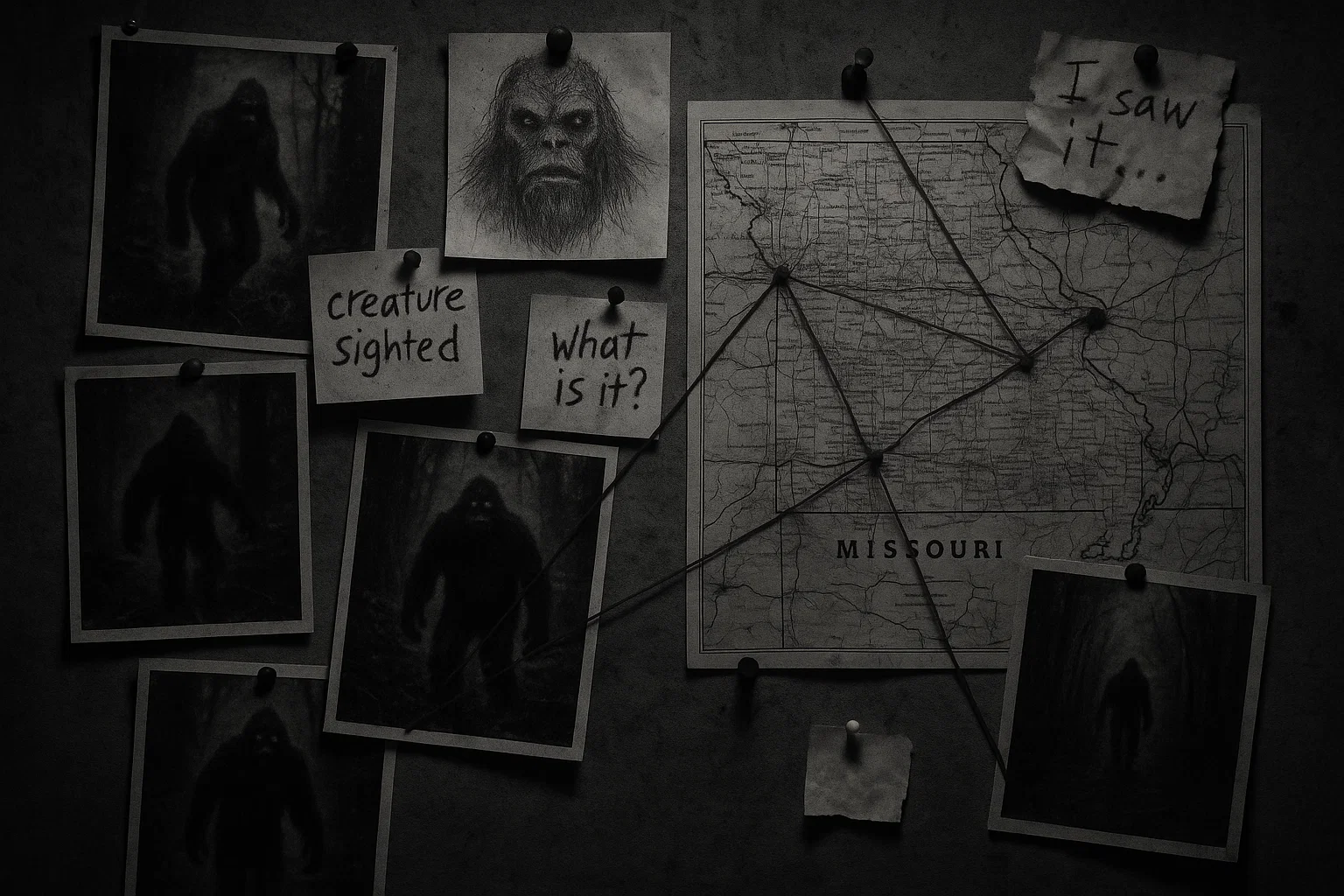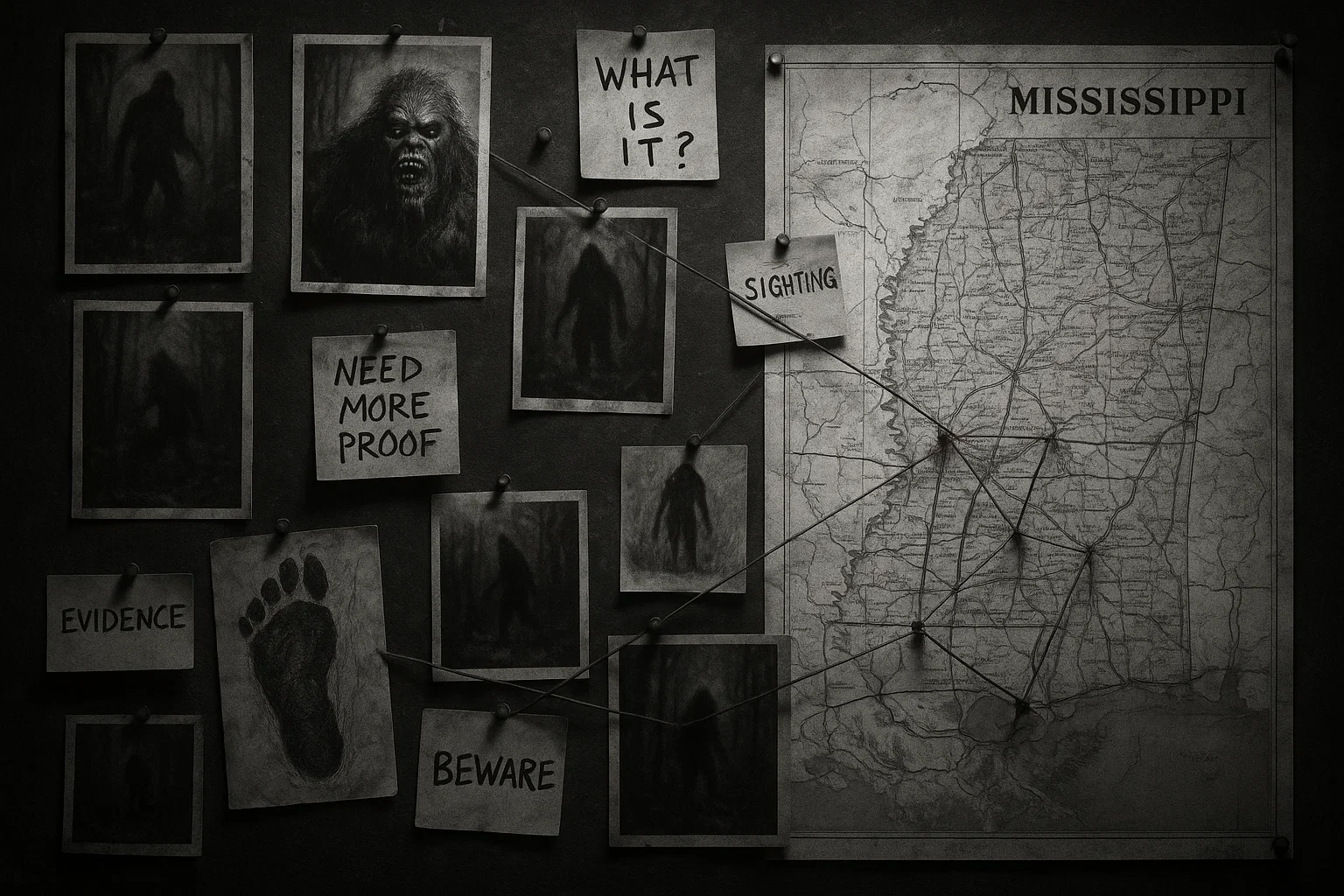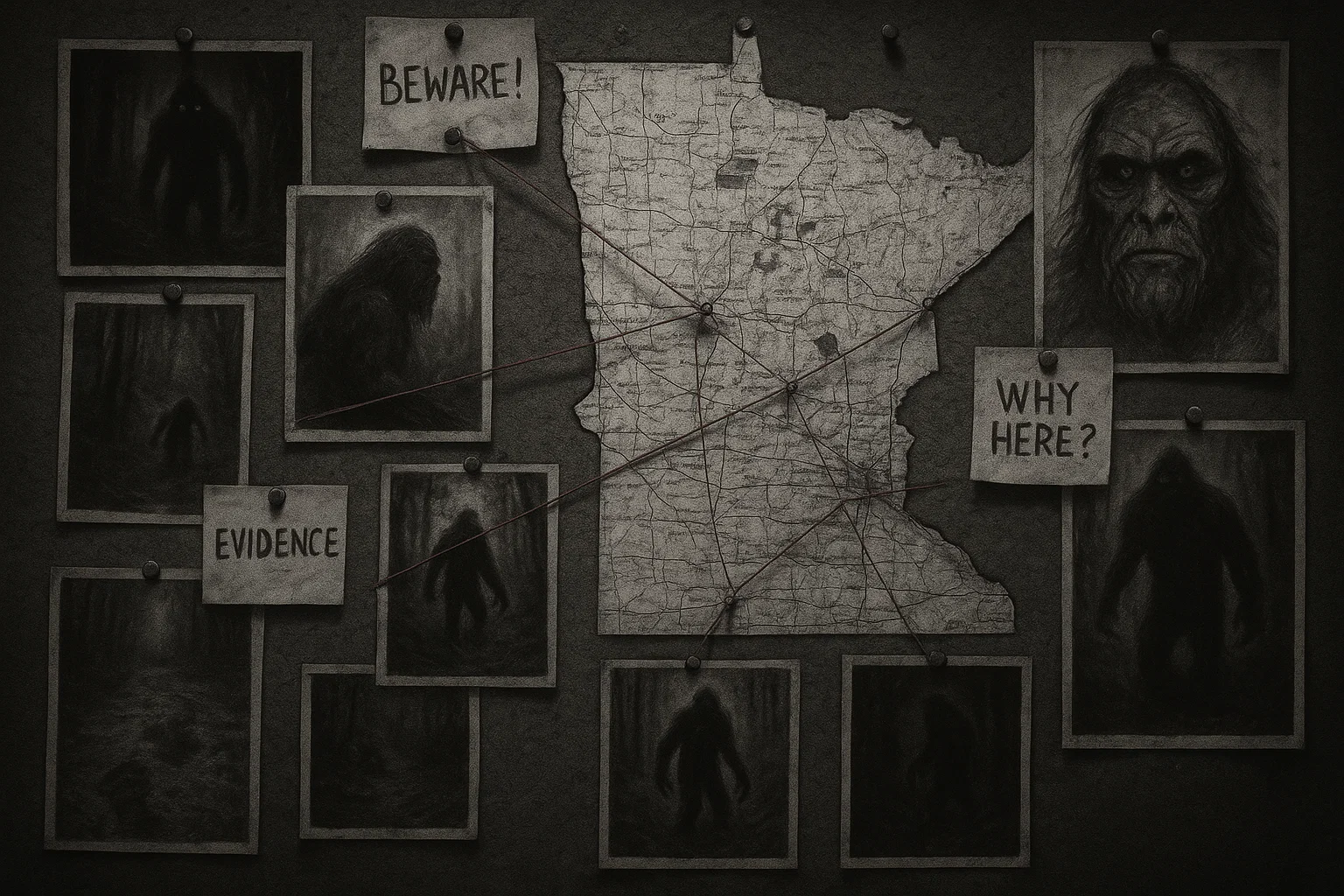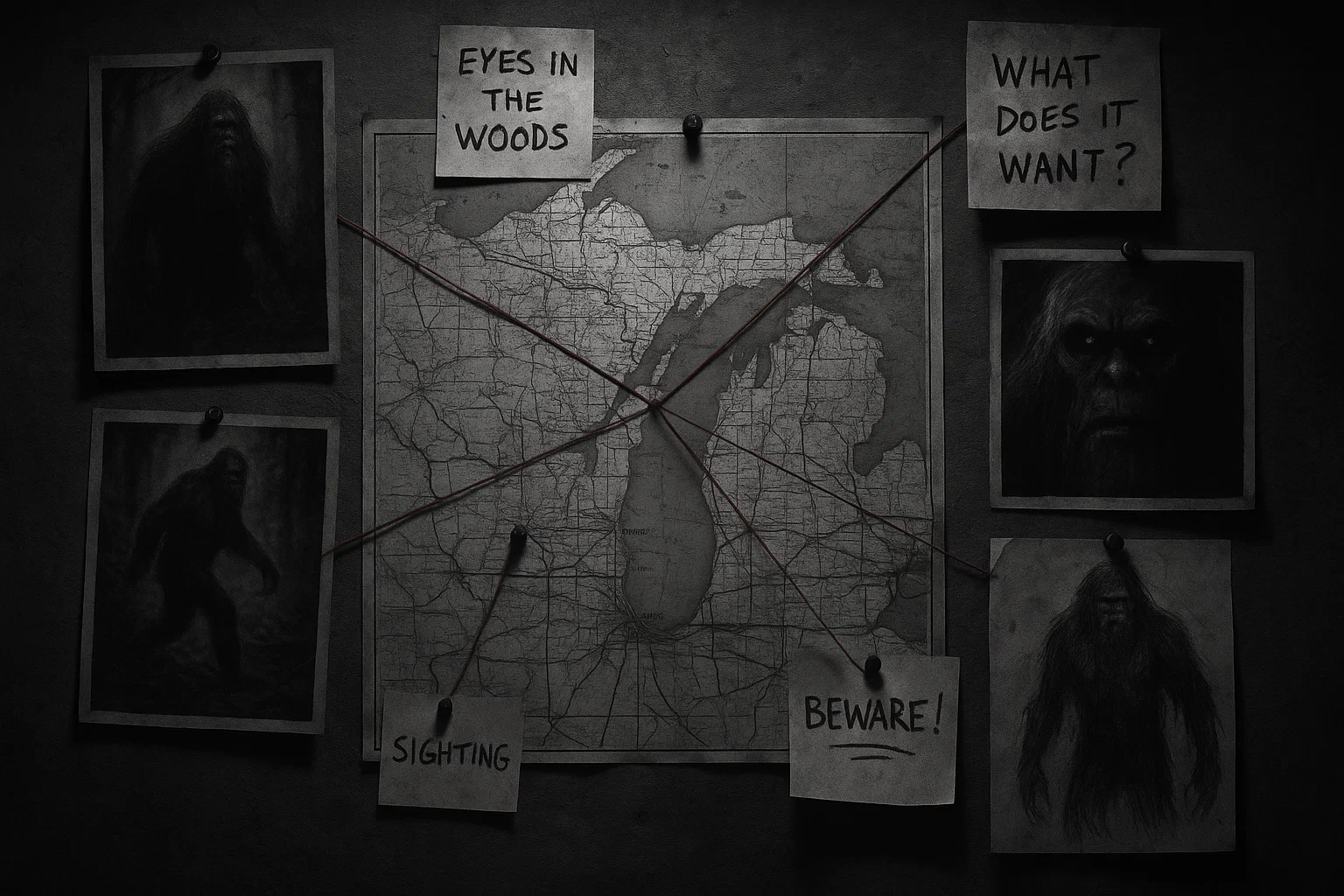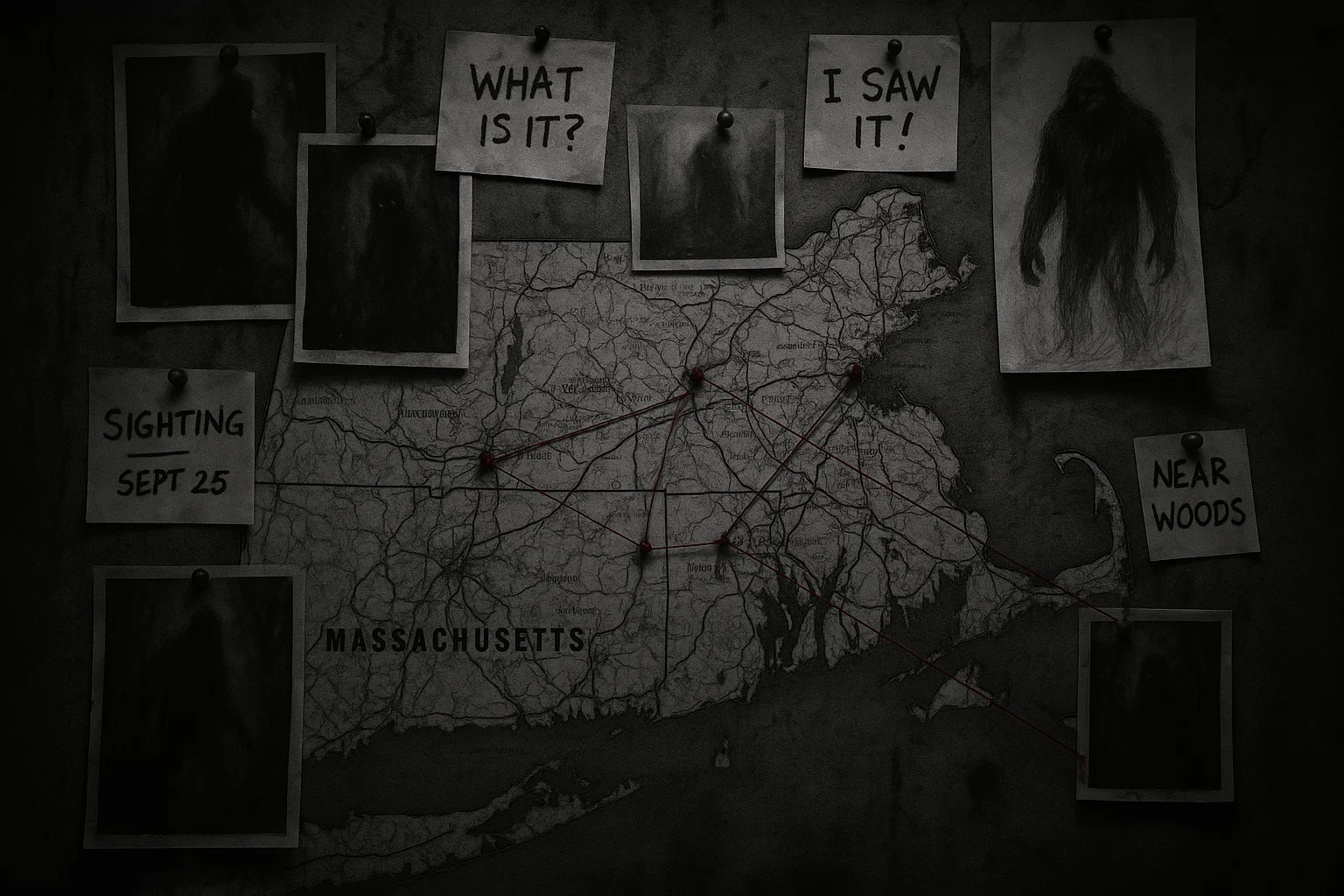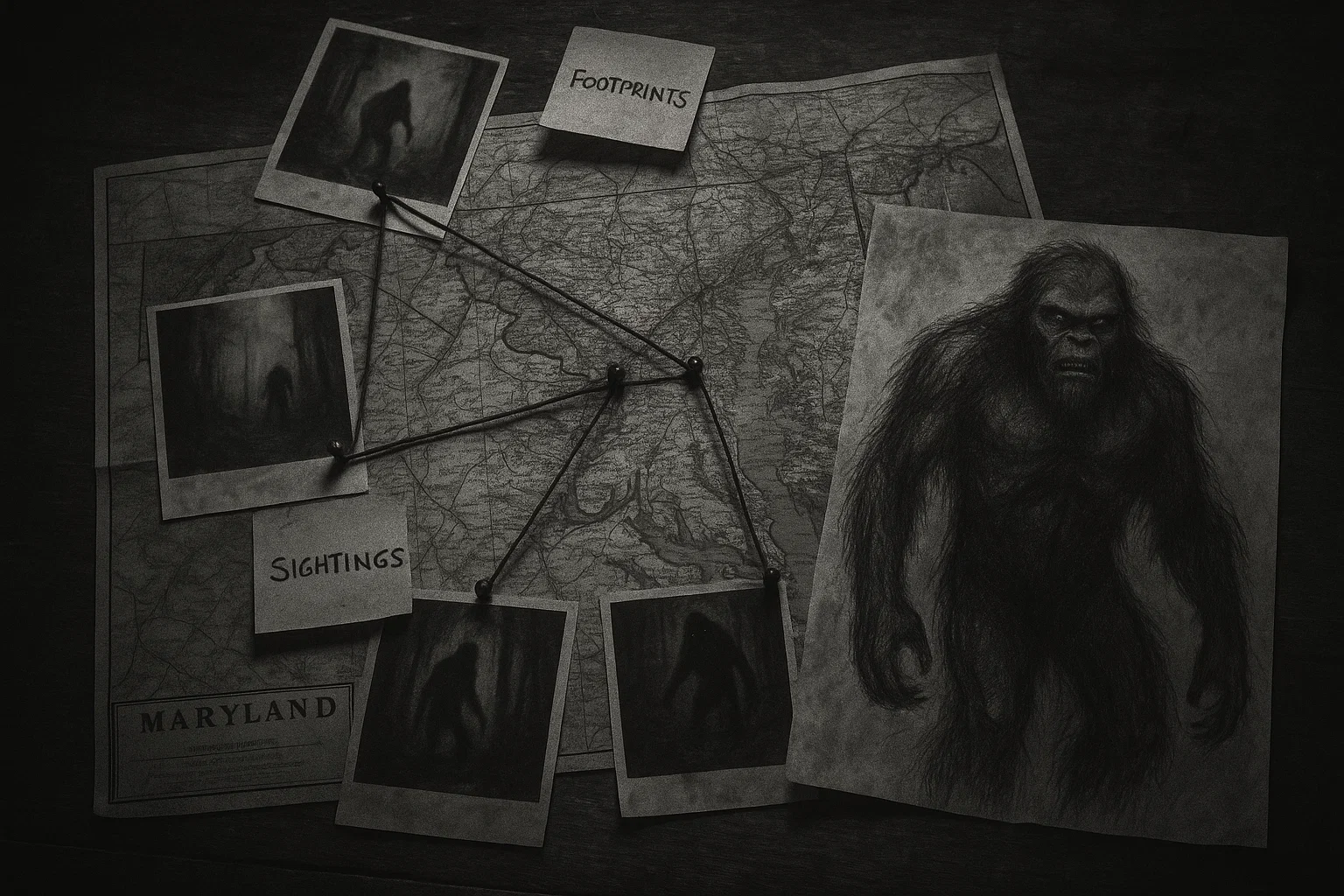Iowa, with its vast cornfields and serene prairies, might seem an unlikely setting for tales of a mysterious, ape-like creature. Yet, Iowa Bigfoot sightings have captivated residents and researchers for decades, with reports of a towering, hairy figure roaming the state’s forests and river valleys.
The phenomenon of Bigfoot sightings in Iowa blends folklore, eyewitness accounts, and scientific inquiry, creating a rich tapestry of intrigue. This article delves into the history, key cases, investigative efforts, and connections to other cryptid phenomena in Iowa, offering a comprehensive exploration of this enduring mystery.
Table of Contents
Iowa Bigfoot Sightings
The phenomenon of Bigfoot sightings in Iowa spans over half a century, with the Bigfoot Field Researchers Organization (BFRO) documenting 78 credible reports as of 2025. These encounters are scattered across Iowa’s diverse landscapes, from the lush, forested bluffs along the Mississippi River to the secluded river valleys of central Iowa. Witnesses consistently describe a creature 7–9 feet tall, covered in shaggy, dark fur, often accompanied by a pungent odor, eerie vocalizations, or massive footprints, aligning with classic Sasquatch characteristics.
Humboldt County leads with nine reported sightings, followed by Dubuque and Dallas Counties with six each. Other notable areas include Scott, Lee, and Allamakee Counties, particularly near Yellow River State Forest. The state’s mix of dense woodlands, riverine habitats, and rural expanses provides ample cover for a creature said to be elusive and nocturnal. Iowa Bigfoot sightings often occur near water sources, such as the Des Moines, Raccoon, and Skunk Rivers, suggesting a possible ecological preference.
Historical Context and Patterns
The earliest recorded Iowa Bigfoot sightings date back to the 1960s, with reports of fleeting glimpses in rural areas. By the 1970s, sightings grew more detailed, including the infamous Lockridge Monster case in Lee County. The 1980s and 1990s saw increased activity, particularly in eastern Iowa, with reports of screams, knocks, and tracks. Modern sightings, like the 2021 White Water Canyon encounter, have leveraged technology, with photographs and videos fueling public fascination.
Patterns in Bigfoot sightings in Iowa include nocturnal activity, proximity to water, and sightings in transitional zones between forests and fields. Witnesses range from farmers and hunters to campers and truck drivers, adding credibility to the accounts. The consistency of descriptions—tall, bipedal, hairy, with glowing eyes or a foul stench—suggests a shared phenomenon, though skeptics attribute these to misidentifications of bears or hoaxes.
Below is a detailed table of notable Iowa Bigfoot sightings, compiled from BFRO reports and local accounts, organized chronologically. The table includes only documented sightings with verifiable details, avoiding speculative or fabricated entries. Witness names are included where publicly available; anonymous reports are noted as such.
| Date | Witness | Location | Description |
|---|---|---|---|
| 1965 | Anonymous | Allamakee County, Yellow River State Forest | A farmer saw a tall, dark figure crossing a field at dusk, leaving large tracks. |
| 1971 | Anonymous | Montrose, Lee County | A woman on horseback saw a hairy, upright creature near a creek; it fled quickly. |
| 1975 | Herbert Peiffer | Lockridge, Lee County | A hairy, ape-like creature, about 5 feet tall with a monkey-like face, seen in tractor headlights near turkey carcasses. |
| 1976 | Anonymous | Montrose, Lee County | Same woman from 1971 reported another sighting of a similar creature on her property. |
| 1985 | Anonymous | Keokuk, Lee County | Three ATV riders heard a loud, guttural roar near a creek, accompanied by a sewage-like smell; found 13-inch footprints the next day. |
| 1989 | Anonymous | Eldridge, Scott County | A camper observed a 7–9-foot creature near a campsite, accompanied by screams; no tracks reported. |
| 2001 | Anonymous | Near St. Louis (Iowa side), Lee County | A large, hairy figure seen crossing a field at night; reported to BFRO as a Class A sighting. |
| 2009 | Jesse Alne | Waterloo, Black Hawk County | Saw a 7-foot creature with glowing red eyes push over a tree; pursued but outrun by the creature. |
| 2015 | Anonymous | Cascade, Dubuque County | A bow hunter saw a “big hairy man-like thing” on family property; multiple sightings reported through 2016. |
| 2016 | Anonymous | Cascade, Dubuque County | Same hunter reported additional sightings of a similar creature; heard knocks and screams. |
| 2017 | Anonymous | Protivin, Chickasaw County | A couple heard two loud knocks in a rural neighborhood, attributed to possible Bigfoot activity. |
| 2021 | Jeremy (anonymous) | Bernard, Dubuque County, White Water Canyon | Photographed a blurry, dark, upright figure among trees; image went viral, sparking debate. |
| 2024 | Anonymous | Humboldt County | A hiker reported a tall, hairy figure near a river; heard eerie howls; classified as Class B by BFRO. |
| 2025 | Anonymous | Yellow River State Forest, Allamakee County | A camper reported a large, bipedal figure with glowing eyes; BFRO expedition planned to investigate. |
You May Also Like: Complete Guide to Florida Bigfoot Sightings (1818–2025)
Investigation Efforts in Iowa
Bigfoot Field Researchers Organization (BFRO)
The BFRO, founded in 1995, remains the leading authority on Bigfoot sightings in Iowa. Its database classifies sightings into Class A (clear, reliable), Class B (credible but less clear), and Class C (secondhand or vague).
In Iowa, BFRO investigators like Steve Moon, an anthropologist with degrees from Iowa State University, have interviewed witnesses and analyzed physical evidence, such as footprints and audio recordings. Moon’s work emphasizes Iowa’s ecological suitability, noting that the state’s river valleys and forests provide ample resources for a large, elusive creature.
In 2019, the BFRO collaborated with the Animal Planet series Finding Bigfoot, which explored Yellow River State Forest in Allamakee County. The team, led by Matt Moneymaker, recorded strange vocalizations and glimpsed a large, hairy figure, though evidence remained inconclusive.
A 2025 BFRO expedition is planned for Iowa, targeting areas like Yellow River and the Skunk River Valley, where sightings are frequent. These expeditions involve night hikes, audio baiting with Bigfoot calls (ape-like howls), and plaster casting of tracks, aiming to gather definitive proof.
Calhoun County Paranormal Investigators
The Calhoun County Paranormal Investigators, founded by brothers Seth and Jesse Alne in 2005, have become key players in Iowa’s Bigfoot research. Initially focused on ghost hunting, the group pivoted to Sasquatch investigations after Jesse’s 2009 encounter in Waterloo, where he saw a 7-foot creature with glowing red eyes topple a tree.
Their 2020 documentary, Squatch Iowa, chronicles their hunts across Iowa, including Yellow River State Forest and the Des Moines River Valley. The film, which won an award at the VIDI SPACE FILM FESTIVAL, features audio of eerie howls, plaster casts of footprints, and interviews with local witnesses.
The Alnes use advanced equipment, including thermal cameras, motion sensors, and audio recorders, to detect signs of Bigfoot. They also employ wood knocks—striking trees to elicit responses—and have recorded potential replies in rural Iowa.
Their work aims to validate witnesses’ experiences, creating a safe space for Iowans to share encounters without fear of ridicule. The group’s YouTube channel, with over 360,000 views on some videos, has amplified Iowa’s place in Bigfoot lore.
Iowa Bigfoot Information Center
Founded in the 1970s by Kevin Cook, the Iowa Bigfoot Information Center is a lesser-known but significant effort to document Iowa Bigfoot sightings. Based in Des Moines, the center collected reports from across the state, focusing on central Iowa’s river corridors. Cook, a retired police officer, interviewed witnesses and archived physical evidence, such as plaster casts and photographs.
Though less active today, the center’s early work laid the groundwork for modern investigations, with Cook’s archives referenced by contemporary researchers like Jeremiah Byron of the Bigfoot Society podcast.
Other Investigative Efforts
Local groups like the Midwest Sasquatch Research Team, based in eastern Iowa, have conducted field investigations in Dubuque and Scott Counties. This team, formed in 2018, focuses on community engagement, hosting town halls to collect witness testimonies. Their 2023 investigation near Davenport documented unusual tree structures—branches arranged in patterns thought to be Bigfoot markers—though no definitive evidence was found.
Independent researchers, such as cryptozoologist Lucas Jennings, have explored the Skunk River Valley, where legends of Wildmen—tall, hairy creatures resembling Bigfoot—persist. Jennings’ work emphasizes ecological analysis, suggesting Iowa’s riverine habitats could sustain a small population of large primates.
Additionally, the Twisted Pine Homestead YouTube channel has gained traction for its detailed breakdowns of Iowa sightings, combining witness interviews with drone footage of sighting locations.
You May Also Like: Complete Guide to Georgia Bigfoot Sightings (1957–2025)
Challenges and Skepticism
Investigating Bigfoot sightings in Iowa faces significant hurdles. The lack of physical remains, clear photographs, or DNA evidence fuels skepticism, with critics suggesting sightings are misidentified black bears, which are rare but present in Iowa. Hoaxes, such as fabricated footprints, further complicate research.
However, investigators counter that the consistency of witness accounts, spanning decades and regions, suggests something unexplained. The psychological aspect—witnesses risking ridicule to share stories—adds weight to their credibility, though scientific proof remains elusive.
Detailed Case Studies
Case Study 1: The Lockridge Monster (1975)
In October 1975, the small town of Lockridge in Lee County became the epicenter of one of Iowa’s most famous Bigfoot sightings. Farmer Herbert Peiffer was checking his turkey flock at dusk when his tractor headlights illuminated a strange figure at the edge of a wooded area. He described it as a hairy, ape-like creature, approximately five feet tall, with a monkey-like face and dark, shaggy fur. Startled, Peiffer retreated to his farmhouse and contacted authorities, but the creature had vanished by the time a deputy arrived.
The next day, hunter Lowell Adkins discovered four partially devoured turkeys near the sighting location, along with unusual tracks—smaller than typical Bigfoot prints but distinctly humanoid. Another farmer, Gloria Olsen, reported seeing a similar creature prowling her cornfields at night, describing its glowing eyes and simian features. The Lockridge Monster, as it was dubbed, gained national attention, with local newspapers speculating about its origins. Unlike classic Bigfoot descriptions, its smaller stature and apparent carnivorous behavior set it apart, leading some to classify it as a distinct cryptid.
Investigations by local authorities found no conclusive evidence, but the consistency of descriptions and physical traces like tracks intrigued researchers. The BFRO later classified the sighting as Class A due to multiple witnesses and physical evidence. To this day, the Lockridge Monster remains a cornerstone of Iowa’s cryptozoological history, with local lore suggesting it still lurks in Lee County’s dense woods.
You May Also Like: Complete Guide to Idaho Bigfoot Sightings (1967–2025)
Case Study 2: White Water Canyon Sighting (2021)
On a July morning in 2021, a man named Jeremy, walking with his sister in White Water Canyon near Bernard, Dubuque County, experienced a sighting that would become one of Iowa’s most publicized Bigfoot sightings. While hiking through the canyon’s dense forest, Jeremy noticed a tall, dark figure standing among the trees, partially obscured by foliage.
He estimated it to be 7–8 feet tall, covered in dark, matted fur, and standing upright like a human. His sister initially thought it was a person, but when they called out, the figure remained silent and swiftly retreated into the underbrush.
Jeremy managed to capture a photograph with his phone, showing a blurry, humanoid shape. The image, shared on social media, went viral, appearing on television programs and sparking heated debate. Believers hailed it as compelling evidence of Bigfoot, citing the figure’s size and posture. Skeptics argued it could be a person in a costume or a bear, though black bears are rare in Dubuque County.
Jeremy, a self-described skeptic before the encounter, insisted on its authenticity, stating, “It was really there. I know what I saw.” The BFRO classified the sighting as Class B due to the unclear photograph but noted its consistency with other Dubuque County reports, such as the 2015–2016 Cascade sightings.
Follow-up investigations by the BFRO and local enthusiasts found no additional evidence, but the canyon’s rugged terrain and proximity to the Mississippi River make it a plausible habitat. The sighting reinvigorated interest in Iowa Bigfoot sightings, with researchers noting the area’s history of unexplained activity, including earlier reports of screams and knocks.
Bigfoot Sightings vs. Other Cryptid Sightings in Iowa
Iowa’s cryptozoological landscape extends beyond Bigfoot to include other enigmatic creatures. The Lockridge Monster, discussed earlier, is a prime example, distinguished by its smaller size and carnivorous traits. In contrast, the Van Meter Visitor, reported in October 1903 in Van Meter, Dallas County, is a wholly different entity.
Described by multiple townspeople, including prominent citizens like a doctor and a banker, as a half-human, half-animal creature with enormous bat wings and a glowing horn on its head, it emitted a powerful stench and moved at incredible speeds. Over several nights, residents attempted to hunt it, chasing two such creatures into an abandoned coal mine, where they vanished.
The Skunk River Wildmen, reported in the Skunk River Valley, are closer to Bigfoot in description. Locals have long told of 7–8-foot-tall, hairy, bipedal creatures roaming the valley’s dense woods. A 2018 sighting near Burlington described a tall, shaggy figure with long arms, echoing classic Sasquatch traits but lacking the detailed evidence of other cases.
You May Also Like: Complete Guide to Illinois Bigfoot Sightings (1880–2025)
Paranormal and Supernatural Events
Iowa’s history of unexplained phenomena extends to UFOs and ghostly apparitions. In 1978, a farmer in Clarion, Wright County, reported a glowing, disc-shaped object hovering over his fields, accompanied by strange lights.
The Rensselaer Russell House Museum in Waterloo, investigated by the Calhoun County Paranormal Investigators, is a hotspot for ghostly activity, with reports of disembodied voices and moving objects. In 2014, a group of teenagers in Council Bluffs claimed to see a translucent figure in a cemetery, described as a spectral entity rather than a cryptid.
Potential Links to Bigfoot
The Lockridge Monster shares enough similarities with Bigfoot—hairy, bipedal, nocturnal—to suggest a possible connection, though its smaller size and behavior raise questions. The Van Meter Visitor, with its supernatural features like wings and a glowing horn, seems unrelated, though its presence in Iowa’s folklore highlights the state’s propensity for mysterious creatures.
The Skunk River Wildmen align closely with Bigfoot descriptions, potentially representing regional variations of the same phenomenon. Some researchers, like Seth Alne, propose that Bigfoot could have a spiritual or extraterrestrial origin, potentially linking it to UFO sightings or paranormal events, though no concrete evidence supports this.
Native American tribes, such as the Meskwaki and Ho-Chunk, have legends of forest spirits or guardians that some interpret as early Bigfoot accounts. These beings, often described as protectors of nature, differ from modern Sasquatch reports in their spiritual context but add cultural depth to Iowa’s cryptid lore.
The lack of definitive proof keeps these connections speculative, but the overlap in sighting locations—often near rivers or forests—suggests Iowa’s ecosystems may harbor multiple unexplained phenomena.
You May Also Like: Complete Guide to Indiana Bigfoot Sightings (1973–2025)
Conclusion
Iowa Bigfoot sightings weave a compelling narrative of mystery, blending eyewitness accounts, dedicated investigations, and rich folklore. With 78 documented reports, Iowa stands as an unexpected hub for Sasquatch activity, challenging perceptions of the Heartland as merely agricultural.
The Lockridge Monster and White Water Canyon sightings highlight the diversity and intrigue of these encounters, while efforts by the BFRO, Calhoun County Paranormal Investigators, and others underscore a commitment to uncovering the truth. Whether Bigfoot is a flesh-and-blood creature, a misidentified animal, or a cultural phenomenon, its presence in Iowa’s forests and fields continues to captivate.
As investigations persist and new reports emerge, the enigma of Bigfoot sightings in Iowa invites us to question what lies beyond the known, keeping the spirit of exploration alive in America’s heartland.

